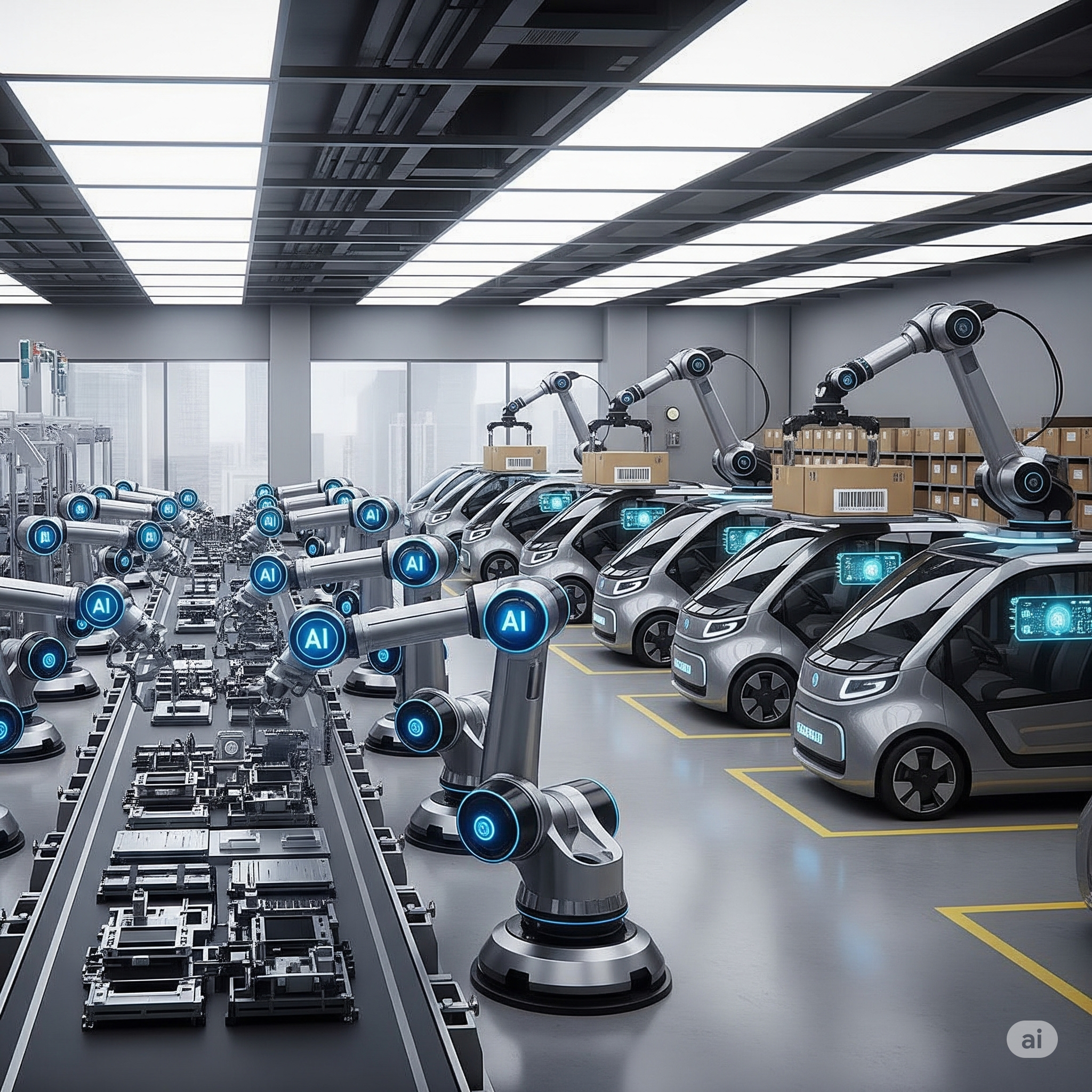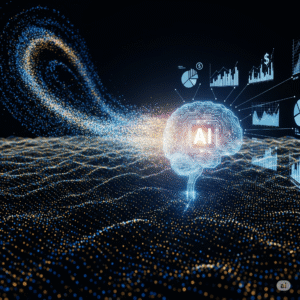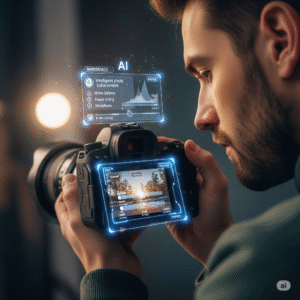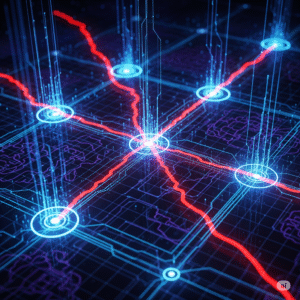The hum of machinery and the movement of goods have long been the defining sounds of manufacturing and logistics. But a new symphony is emerging, one orchestrated by the seamless collaboration of artificial intelligence (AI) and robotics. AI robotics in industry are no longer a futuristic fantasy; they are a tangible reality, rapidly transforming how products are made, moved, and delivered. From agile robots on the factory floor to intelligent systems optimizing complex supply chains, the integration of AI is ushering in an era of unprecedented efficiency, flexibility, and innovation. For businesses striving for a competitive edge in today’s dynamic global market, understanding and embracing the power of AI robotics in industry is not just an option—it’s a necessity for survival and growth.
The traditional image of industrial robots often involves fixed, repetitive tasks. While these robots have undoubtedly increased productivity, they lack the adaptability and intelligence to handle the complexities of modern manufacturing and logistics. This is where AI steps in, providing robots with the “brains” to perceive their environment, make decisions, and learn from experience. The fusion of AI and robotics creates a new generation of intelligent machines capable of performing a wider range of tasks with greater autonomy and precision. This evolution of AI robotics in industry is unlocking solutions to challenges that were previously insurmountable, paving the way for smarter, more resilient, and ultimately more profitable operations.
The Intelligent Edge: AI Capabilities Empowering Industrial Robots
The transformative power of AI robotics in industry stems from the diverse AI capabilities that are being integrated into these physical systems. These intelligent features enable robots to move beyond pre-programmed routines and interact with their surroundings in a more dynamic and responsive manner.
Enhanced Perception and Navigation
AI algorithms, combined with advanced sensors like cameras, lidar, and sonar, provide robots with a sophisticated understanding of their environment. This allows them to navigate complex and dynamic workspaces, identify objects, avoid obstacles, and even work safely alongside human colleagues. In logistics, AI-powered robots can autonomously navigate warehouses, locate specific items, and optimize routes for picking and packing, significantly improving efficiency in AI robotics in industry.
Adaptive Control and Dexterity
Traditional industrial robots often struggle with tasks requiring fine motor skills or adaptability to variations in parts or processes. AI-driven control systems enable robots to learn and refine their movements, allowing them to handle delicate objects, perform intricate assembly tasks, and adjust to unexpected changes in the production line. This enhanced dexterity and adaptability expand the range of tasks that can be automated by AI robotics in industry.
Predictive Maintenance and Diagnostics
AI algorithms can analyze data from robot sensors to detect patterns that indicate potential equipment failures. This predictive maintenance capability allows for proactive intervention, minimizing downtime and reducing maintenance costs. AI can also assist in diagnosing the root causes of malfunctions, enabling faster repairs and improving the overall reliability of AI robotics in industry deployments.
Collaborative Robotics (Cobots)
One of the most exciting developments in AI robotics in industry is the rise of collaborative robots, or cobots. Equipped with AI-powered safety features and advanced sensing, cobots can work safely in close proximity to human workers, assisting with tasks that are ergonomically challenging, repetitive, or require a combination of human dexterity and robotic strength. This human-robot collaboration enhances productivity and improves worker safety.
Real-World Impact: AI Robotics Transforming Manufacturing and Logistics
The integration of AI robotics in industry is no longer a theoretical concept; it’s driving tangible results across various sectors. Here are some compelling examples of how businesses are leveraging these intelligent machines:
Manufacturing: Precision, Speed, and Flexibility
In manufacturing, AI robotics in industry are being deployed for tasks ranging from welding and painting to complex assembly and quality control. AI-powered vision systems can inspect products with greater accuracy than human inspectors, identifying even minute defects. Robots equipped with machine learning algorithms can adapt their assembly processes based on real-time data, leading to increased efficiency and reduced waste. Companies adhering to principles outlined by organizations like HubSpot are recognizing the competitive advantage offered by these technologies.
Logistics and Warehousing: Streamlining the Supply Chain
The logistics and warehousing sectors are experiencing a significant transformation driven by AI robotics in industry. Autonomous mobile robots (AMRs) are navigating warehouses to fulfill orders, while robotic arms are automating packing and sorting tasks. AI-powered systems optimize warehouse layouts and manage inventory in real-time, leading to faster order fulfillment, reduced labor costs, and improved accuracy. Concepts like “lights-out” warehousing, where fully automated facilities operate with minimal human intervention, are becoming increasingly feasible thanks to advancements in AI robotics in industry.
Case Study 1: Automotive Manufacturing with Intelligent Assembly Robots
A leading automotive manufacturer implemented AI robotics in industry for the assembly of intricate engine components. Traditional fixed robots struggled with the variations in part tolerances and required frequent reprogramming. By integrating AI-powered robots with advanced vision systems and adaptive control algorithms, the manufacturer achieved a 30% increase in assembly speed and a 99.9% accuracy rate. The AI system also learned from past assembly data to predict potential issues and optimize the robot’s movements over time, showcasing the power of AI robotics in industry.
The Quantum Leap: How Quantum AI Impact Will Reshape Future Professions
Case Study 2: E-commerce Fulfillment with AI-Driven Warehouse Robots
A major e-commerce retailer deployed a fleet of autonomous mobile robots (AMRs) in its fulfillment centers, guided by an AI-powered warehouse management system. These robots autonomously navigated the warehouse floor, located and retrieved items for customer orders, and transported them to packing stations. This implementation of AI robotics in industry resulted in a 50% reduction in order fulfillment time and a significant decrease in labor costs during peak seasons. The AI system continuously optimized robot routes and task assignments based on real-time order data and warehouse traffic.
AI in the Metaverse is Revolutionizing Professional Training
Key Tools and Technologies Driving AI Robotics in Industry
The advancement of AI robotics in industry is fueled by a confluence of cutting-edge tools and technologies:
- Machine Learning Platforms: Frameworks like TensorFlow (maintained by Google) and PyTorch provide the foundation for developing the AI algorithms that power intelligent robots.
- Computer Vision Libraries: Libraries such as OpenCV enable robots to “see” and interpret visual information from cameras.
- Robot Operating System (ROS): An open-source framework that provides a standardized software infrastructure for building complex robotic systems.
- Industrial Robot Manufacturers: Companies like ABB, Fanuc, and KUKA are integrating AI capabilities into their latest generation of industrial robots.
- AI-Powered Simulation Software: Tools that allow for the virtual testing and optimization of robot deployments before physical implementation.
Implementing AI Robotics: A Strategic Approach
Adopting AI robotics in industry requires careful planning and a strategic approach. Here are some key considerations for businesses looking to integrate these technologies:
- Identify Target Processes: Pinpoint specific manufacturing or logistics processes that are labor-intensive, prone to errors, or could benefit significantly from automation and increased efficiency through AI robotics in industry.
- Define Clear Objectives and KPIs: Establish measurable goals for your AI robotics in industry deployment, such as increased throughput, reduced costs, improved quality, or enhanced safety.
- Start with Pilot Projects: Begin with small-scale deployments in controlled environments to test the technology and gather valuable data and insights before full-scale implementation of AI robotics in industry.
- Focus on Integration: Ensure that your AI-powered robots can seamlessly integrate with your existing systems, including enterprise resource planning (ERP) and warehouse management systems (WMS). Platforms like Zapier can sometimes facilitate these integrations.
- Invest in Training and Upskilling: Prepare your workforce for the integration of AI robotics in industry by providing training on how to work alongside these intelligent machines and maintain the new systems.
- Consider Safety and Ethics: Implement robust safety protocols for human-robot interaction and address any ethical considerations related to automation and job displacement. Resources from organizations like OpenAI on the ethical implications of AI can be valuable.
The Future Forged by Intelligent Automation
AI robotics in industry represent a paradigm shift in how we approach manufacturing and logistics. By endowing machines with intelligence, we are unlocking new levels of automation, efficiency, and adaptability. As AI algorithms become more sophisticated and robot hardware continues to advance, the potential applications of AI robotics in industry will only continue to expand. Businesses that strategically embrace this technological revolution will be well-positioned to thrive in the increasingly competitive and dynamic global landscape, forging a future where intelligent machines and human ingenuity work in concert to drive progress and prosperity.



